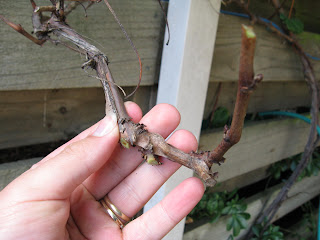Pruning in the commercial sense basically "stresses" the vine, and encourages it to produce a larger yielding of fruit. Great if you are a vineyard owner, or wanting t
o make your own home wines.
Pruning in my case, though, means keeping the vine in a manageable state; grape vines especially are notorious for growing wildly in all directions in a huge mess, and since I am trying to train it on the fence to keep it tidy, this means I'm going to spend some time picking and choosing the direction I want it to grow in.
This requires clipping back last years growth.
Pruning in my case, though, means keeping the vine in a manageable state; grape vines especially are notorious for growing wildly in all directions in a huge mess, and since I am trying to train it on the fence to keep it tidy, this means I'm going to spend some time picking and choosing the direction I want it to grow in.
This requires clipping back last years growth.
As
you can see here, this vine has grown in tandem with a honeysuckle,
which, for the majority of it's years, was not to it's advantage. I cut
the honeysuckle back severely about two years ago, and the vine has been
doing much better. The honeysuckle seems to be doing just fine as well.
So! Here's what to look for when you're pruning.
The section of the trunk of the vine with all the stringy gray-brown bark is the older wood, usually two or more years old. Generally, this won't bear fruit, or even sprout much, though if you have a lot of grapes, you will encounter vines that throw out suckers like there is no tomorrow. Just scrape those off before they lignify (harden into proper fruit wood).
The brown lengths of stem are the fruiting wood. They are last years growth. Every nodule (seen as the slightly swollen "knuckles" along the length of the stem) is a bud. Now, I won't go into all the details about the buds, but what you really need to know is that if these are viable, they will sprout more greenery and stems.
You can control how the vine grows by choosing the buds you want to stay and cutting out the rest. This not only directs the vine, but gets rid of anything that would create much more tangled growth. (Another good idea is to have twine or green gardeners tape handy to secure the vine to your trellis/fence/stake and support it, while training it to grow in that particular direction).
I'll use this section as an example.
What I have here is a forked section of old wood.
One section (seen growing off the bottom of the picture) peters out into a dead branch, has one small (less than a pencils thickness) stem which is sickly looking, and no other viable options.
What I have here is a forked section of old wood.
One section (seen growing off the bottom of the picture) peters out into a dead branch, has one small (less than a pencils thickness) stem which is sickly looking, and no other viable options.
The other fork is a short spur with two nice looking stems (look for ones about as thick as a pencil or a little more; they are generally going to give good results).
One stem is right at the end of the spur (you can just about see the dead, dry remnants of last years pruning), but the other is in a bad spot: too close to the branch and growing back on itself.
So, that one that's growing close to the fork? Just cut it off as close to the old wood as you can.
And,
because the other branch of the fork ended in dead material and had
only a sickly looking stem, just cut that section off too.
Prune your chose stem them to give it two or three buds, and then secure the branch of the vine where you want it. Continue with this process all over the vine until it's all pruned.
Prune your chose stem them to give it two or three buds, and then secure the branch of the vine where you want it. Continue with this process all over the vine until it's all pruned.
You now have a vine that will grow relatively neatly, and still put on quite a bit of fruit if the season is good. I'll get a kilo or two of grapes off this skinny old vine.
The pile of grape cuttings, reading for grafting or sprouting as you see fit.
Because I want have more grapevines growing along the fence in future years, I'm going to attempt to plant some of the stronger stems and see if they will sprout. If they do, I'll plant them along the fence and train them as I do the old vine.
Because I want have more grapevines growing along the fence in future years, I'm going to attempt to plant some of the stronger stems and see if they will sprout. If they do, I'll plant them along the fence and train them as I do the old vine.
Happy pruning, and have a great weekend!








No comments:
Post a Comment
Please feel free to share your comments, questions and experiences.